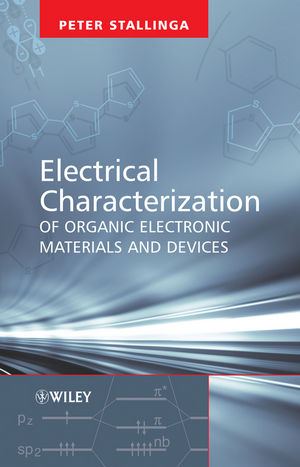Electrical Characterization of Organic Electronic Materials and DevicesISBN: 978-0-470-75009-4
Hardcover
316 pages
November 2009
 |
||||||
1 General concepts.
1.1 Introduction.
1.2 Conduction mechanism.
1.3 Chemistry and the energy diagram.
1.4 Disordered materials and the Meyer–Neldel Rule.
1.5 Devices.
1.6 Optoelectronics/photovoltaics.
2 Two-terminal devices: DC current.
2.1 Conductance.
2.2 DC current of a Schottky barrier.
2.3 DC measurements.
3 Two-terminal devices: Admittance spectroscopy.
3.1 Admittance spectroscopy.
3.2 Geometrical capacitance.
3.3 Equivalent circuits.
3.4 Resistor; SCLC.
3.5 Schottky diodes.
3.6 MIS diodes.
3.7 MIS tunnel diode.
3.8 Noise measurements.
4 Two-terminal devices: Transient techniques.
4.1 Kinetics: Emission and capture of carriers.
4.2 Current transient spectroscopy.
4.3 Thermally stimulated current.
4.4 Capacitance transient spectroscopy.
4.5 Deep-level transient spectroscopy.
4.6 Q-DLTS.
5 Time-of-flight.
5.1 Introduction.
5.2 Drift transient.
5.3 Diffusive transient.
5.4 Violating einstein’s relation.
5.5 Multi-trap-and-release.
5.6 Anomalous transients.
5.7 High current (space charge) transients.
5.8 Summary of the ToF technique.
6 Thin-film transistors.
6.1 Field-effect transistors.
6.2 MOS-FET.
6.3 Introducing TFTs.
6.4 Basic model.
6.5 Justification for the two-dimensional approach.
6.6 Ambipolar materials and devices.
6.7 Contact effects and other simple nonidealities.
6.8 Metallic contacts in TFTs.
6.9 Normally-on TFTs.
6.10 Effects of traps.
6.11 Admittance spectroscopy for the determination of the mobility in TFTs.
6.12 Summary of TFT measurements.
6.13 Diffusion transistor.
Appendix A A Derivation of Equations (2.21), (2.25), (6.95) and (6.101).
Bibliography.
Index.



